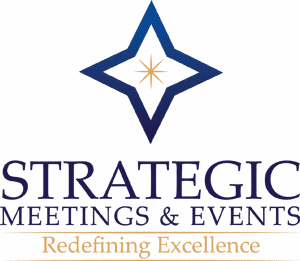Get Ready for a Strategic Shift
By JT Long
Planners who own the “why” deliver better meetings
Imagine an event professional. We will call her Jane. She has been in the meetings industry for more than a decade. She has a “favorites” phone list of suppliers who can make anything happen. Miniature baked Alaska for 1,000—check. Lighting that turns a ballroom into an electric daisy carnival—got it. Need a replacement for an AWOL speaker—Tony Robbins might be free this afternoon. Surveys give her events high marks. But she feels stuck.
Christy Lamagna can pinpoint the problem. “As long as she is a master of logistics, she is an order-taker,” said the author of The Strategic Planning Guide for Event Professionals and owner of Strategic Meetings & Events. “Executing events flawlessly is akin to crossing things off a grocery list. We need to own the role our events take in the success of the company if we are going to elevate the profession. She advises hitting pause on the logistics—the how, so you can rev up the why.”
Deborah Sexton, founder of DLS Association and long-time president and CEO of PCMA, agrees. “We need to own our roles as business event strategists by telling the world, ‘We are not party planners; we can do more,’” she said.
A new sense of urgency has emerged, as some have predicted that automation could replace much of what planners are currently tasked with executing. John Nawn, founder of The Perfect Meeting, says, “This isn’t just about making meetings and events more efficient and effective—it’s about job security.”
It’s time for event professionals to move from the back room to the board room. When the ballroom doors close, too many planners are on the wrong side of it, busy thinking about the buses and room drops instead of monitoring how the content is telling the story. Those tasked with managing the major budgets that meetings now require—$131.9 billion in the United States alone, according to a 2017 study for Meetings Mean Business Coalition—need to have a seat at the executive table. That shift will require handing some of our cherished checklists over to others and adopting a more strategic mindset.
The reward will come in the form of better return on the investment for our companies and possibly a promotion—and a raise.
Smart Meetings talked to experts in the industry pushing for this change to find out what will be required to gain the influence—and respect—required for a strategic shift.
Get to Why
According to a survey for Meetings Mean Business Coalition in 2016, most executives say in-person meetings improve their ability to close deals, network, develop professionally and grow their bottom lines. A whopping 92 percent said they plan to continue to invest in conferences, but too many are not empowering the people who put on those events to maximize their impact.
“Events are Maseratis when it comes to their raw power to move the needle on business objectives, but we are driving them like Priuses to the grocery store,” Lamagna said.
When event professionals are truly in the driver’s seat, they can rev up the purpose and outsource the PowerPoint loading. The career turbo charge that will allow them to make that strategic shift is embodied in three little letters: Why?
Start with the desired end-result. Strategic planners engage in what Lamagna calls a master discovery session to find out the real reason a meeting is taking place in the first place. “We have always held an annual dinner,” is not a valid answer. Even “increasing sales” is not an answer. Dig deeper and get the bigger strategy about the positioning in the market and the messaging the management team wants to deliver.
Sometimes, getting to the ultimate answer requires some informal therapy if the team isn’t all on the same page, because the event professional has to drill down to find consensus. Only when data discovery has been completed and a concrete goal is agreed upon can you design an event that delivers on the real needs of the company.
That discovery process requires asking questions of everyone involved. Lamagna used the example of an annual incentive trip that had become more expensive every year, but was not delivering the motivation envisioned. In fact, employees were complaining about it and management was about to cancel it. Then, she talked to attendees and they said that the problem with the trip wasn’t that it wasn’t valuable: It was that management was using it as a private vacation and ignoring them. She saved money on the trip by cutting some of the more extravagant line items and scheduling time with the CEO so the achievers could be recognized in person. “That was meaningful and motivating and a strategic use of company dollars,” Lamagna said.
By asking the right questions—including “What do you need?” and “What is holding you back?”—you can design events that influence what people think, feel and do. That is a win-win.
Sexton sees the adoption of strategic thinking as an exciting opportunity in the corporate and association sectors. “There will always be a role for logistics, but when you can articulate your value to the c-suite and bring together all the sides of the business touched by events—human resources, marketing, sales and operations—you can be more effective,” she said.
Drive It Home
“Events are the most powerful sales and marketing tool available,” Lamagna said. “Own that power.”
“Owning it” starts with linking to company initiatives the event supports. This clarity of purpose makes prioritizing spending easier. Every decision about what to add to an event and where to cut dollars can be looked at through the filter of “does it support the goal?” If it doesn’t, don’t put the spend in that area.
It also leads to meaningful analysis and measurement at the end of the event. Instead of polling attendees about the breakfast buffet, ask questions that measure behavior. Compare results over time to determine if trainings are actually adding to the skill set.
When properly attributed, events can be seen as self-reliant or even profit-making. Organizations subconsciously divide their employees into those who make money and those who spend it, and guess who gets more attention?
Making the case for the value events bring will require getting comfortable with spreadsheets. Events are a long-term investment and their results need to be tracked over time—great news for planners who often already have lots of data and lists from previous meetings.
“Events should be an ongoing conversation, a speed bump that is reinforced,” Lamagna said. “We know people don’t learn by just hearing something once. Why do we think that reality will change if we have speakers supply multiple pieces of content from a stage?” She suggests distributing important information leading up to the conference and after the event, to reinforce it.
When you are seen as someone who can lead change, those whose job it is to initiate change will seek you out. “You have to position yourself to be the one who creates experiences that drive sales, the things that matter to CEOs, CFOs and CMOs. Then you become the Pied Piper,” Lamagna said.
Model of the Future
Bill Reed did not demand his seat at the table as chief event strategy officer for American Society of Hematology (ASH), the world’s largest professional society concerned with the causes and treatments of blood disorders. He demonstrated his interest in identifying challenges and finding solutions that align with the organization’s overall goals. “Not sitting in the c-suite would be an opportunity lost,” he said. “The best way to create brand reputation is through live events, so it is important that the team executing on that essential mission has a voice early in the conversation. That is how you maximize effectiveness.”
Reed started his zig-zagging career in the industry as a supplier on the hotel side who worked hard to understand the needs of planners. He learned the business at Walt Disney Parks & Resorts, Fairmont Hotels & Resorts and Westin Hotels & Resorts. When he moved to the independent planner side as senior vice president for Experient, he was uniquely positioned to see the host organization and property operations sides. Reed sees his job not as planning meetings, but delivering business results. That means changing how success is delivered. Instead of focusing on staying in budget, he focuses on the bottom line. This sometimes requires investing more money to increase revenue, thereby generating profits. “You can solve a lot of problems when you are growing revenue,” he said. “That is how business people think and that is how you get a seat at the table.” Shifting to a strategic role also makes it less likely that the job will get outsourced.
As a former Professional Convention Management Association chair, Reed has thought a lot about how others could develop a similar approach and determined, “It is not for everyone; you have to really be curious, understand business and marketing and enjoy the strategic approach.”
Today, Reed oversees ASH’s global membership and meetings strategy, portfolio of events and conference center operations—some 500 events a year. ASH’s annual meeting and exhibition is attended by more than 29,000 professionals from 110 countries. He manages this pipeline with a team of six people and it is not a coincidence that his top direct report has an MBA. “I recruit from the ranks of well-rounded people,” Reed said.
Help Wanted
John Nawn, founder of The Perfect Meeting, says before we outline how to shift to an event strategist role, we need to take some time to come to an agreement on what an event strategist is. “An event strategist is a new job title and requires a new job description,” he said.
It’s not a planner on steroids or just a smarter planner. “To date, no one’s conducted a job analysis, so all we’re left with is wishful thinking and semi-educated guesses,” he concluded, pointing to Meeting and Business Event Competency Standards (MBECS) as a good place to start.
When Cisco was looking for a c-level event strategist to work in its San Jose, California, office, the job description specifically called for someone who has portfolio management, event design experience and event content development experience. The high-level duties included “creating an integrated event strategy that takes our most strategic audience segment on a highly personalized and meaningful journey.”
Based on Smart Meetings interviews with leaders in the field, we came up with the following draft job description. Do you have suggestions for fine tuning? Please send them to editor@smartmeetings.com and we will share them on SmartMeetings.com.
Event Strategist
This executive-level person will interface with the c-suite to strategically position live events as an integral part of the organization’s mission to execute on company goals, improve sales, strengthen company culture and advance the brand. This key position will manage return on investment and promote innovation and creativity. The event strategist is also responsible for reporting back on results (beyond attendance and revenue), ideating in real time and proposing improvements that will benefit the long-term growth of the company.
- Competencies
- Asks about goals and objectives
- Skilled in change management and systems thinking
- MBA-level thinking and budgeting skills
- Understands marketing strategy and can put it into action
- Cross-cultural acumen
- Technology geek status
- Versed in behavioral science and empathetic leadership
- Fosters partnerships in the company, and with vendors and strategic organizations
- A communications overachiever (in print, digital and business as well as in person, on stage and in the boardroom)
- A true leader






